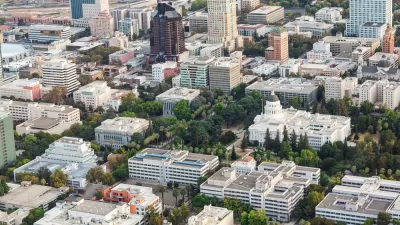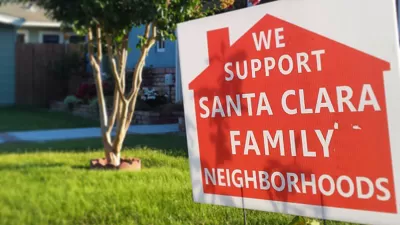University of California, Berkeley researchers have mapped the impact of SB 50, a bill that would allow new density around train stations and bus stops in cities all over the state of California.

A new interactive mapping tool from the urban Displacement Project and the Terner Center for Housing Innovation at the University of California, Berkeley illustrates the potential impact of SB 50, the statewide transit oriented upzoning bill authored by State Senator Scott Weiner as a follow up to last year's SB 827.
Jenna Chandler reports on the new mapping tool, explaining how to use the map to visualize the changes the bill could clear the way for in the name of creating more housing supply and lowering housing costs around the state.
"The analysis and map look at neighborhoods surrounding 'high-quality' transit stops and categorize them into five neighborhood types based on existing density and income: high density and high income (blue); high density and low income (green); low density and high income (red); low density and low income (yellow); and low density and diverse (purple)," explains Chandler.
"They study takes into consideration how much land is zoned for residential uses, how much is vacant and 'underutilized,' and how many existing buildings are renter-occupied. To help prevent displacement, SB 50 has a provision that exempts buildings that have been occupied by tenants within the past seven years."
Carolina Reid, faculty research advisor for the Terner Center for Housing Innovation, is also quoted in the article providing more insight into the message the team hoped to impart in creating the mapping tool.
FULL STORY: Map shows which LA neighborhoods might be impacted by California transit density bill

Planetizen Federal Action Tracker
A weekly monitor of how Trump’s orders and actions are impacting planners and planning in America.

Maui's Vacation Rental Debate Turns Ugly
Verbal attacks, misinformation campaigns and fistfights plague a high-stakes debate to convert thousands of vacation rentals into long-term housing.

Cuomo Is the Candidate of Both NIMBYs and Developers. What Gives?
In the New York City mayoral race, odd bedfellows align to preserve the housing status quo.

The Subversive Car-Free Guide to Trump's Great American Road Trip
Car-free ways to access Chicagoland’s best tourist attractions.

San Antonio and Austin are Fusing Into one Massive Megaregion
The region spanning the two central Texas cities is growing fast, posing challenges for local infrastructure and water supplies.

Charlottesville Temporarily Has No Zoning Code
A judge ordered the Virginia city to throw out its newly revised zoning code, leaving permitting for new development in legal limbo.
Urban Design for Planners 1: Software Tools
This six-course series explores essential urban design concepts using open source software and equips planners with the tools they need to participate fully in the urban design process.
Planning for Universal Design
Learn the tools for implementing Universal Design in planning regulations.
Heyer Gruel & Associates PA
JM Goldson LLC
Custer County Colorado
City of Camden Redevelopment Agency
City of Astoria
Transportation Research & Education Center (TREC) at Portland State University
Jefferson Parish Government
Camden Redevelopment Agency
City of Claremont




























